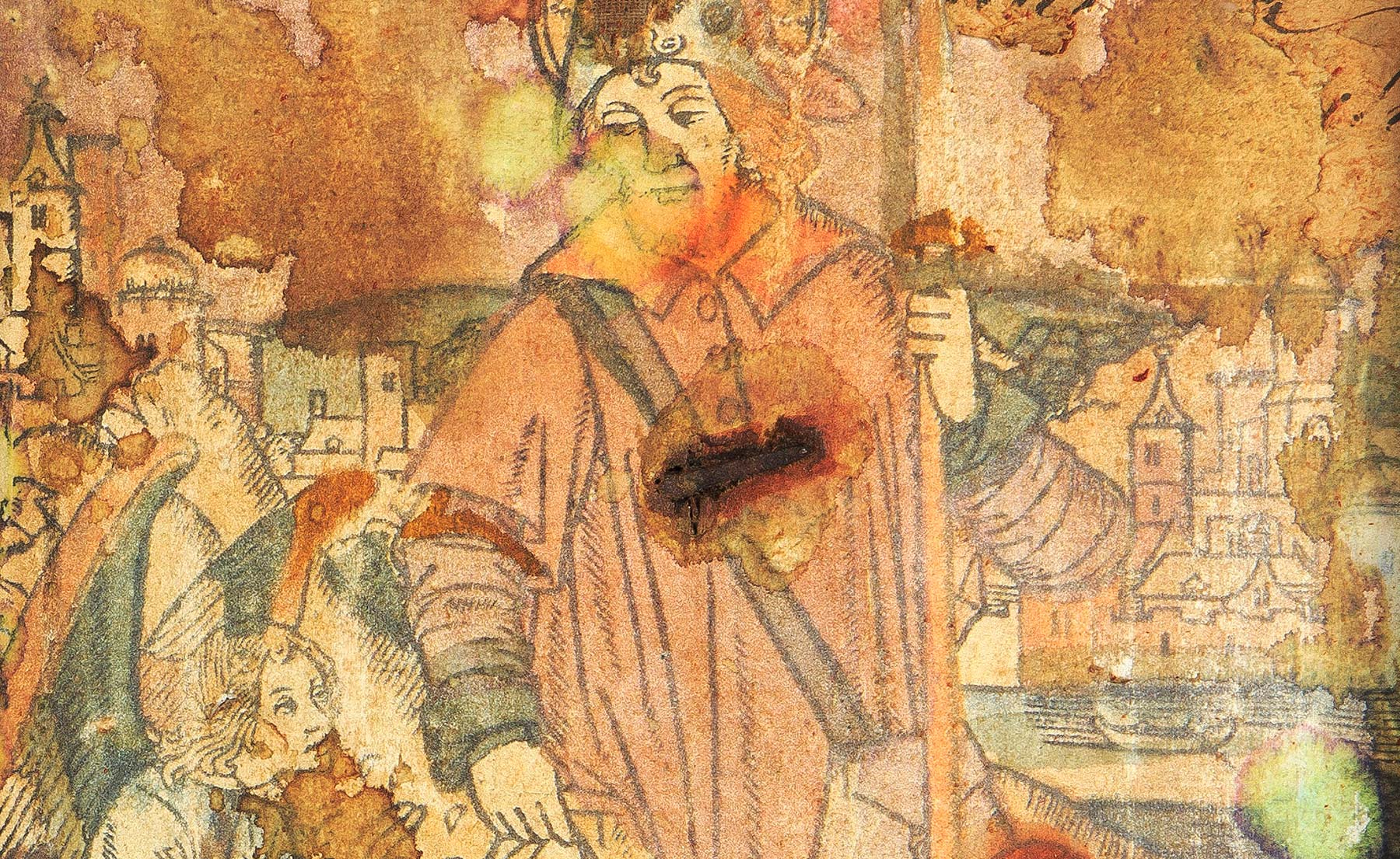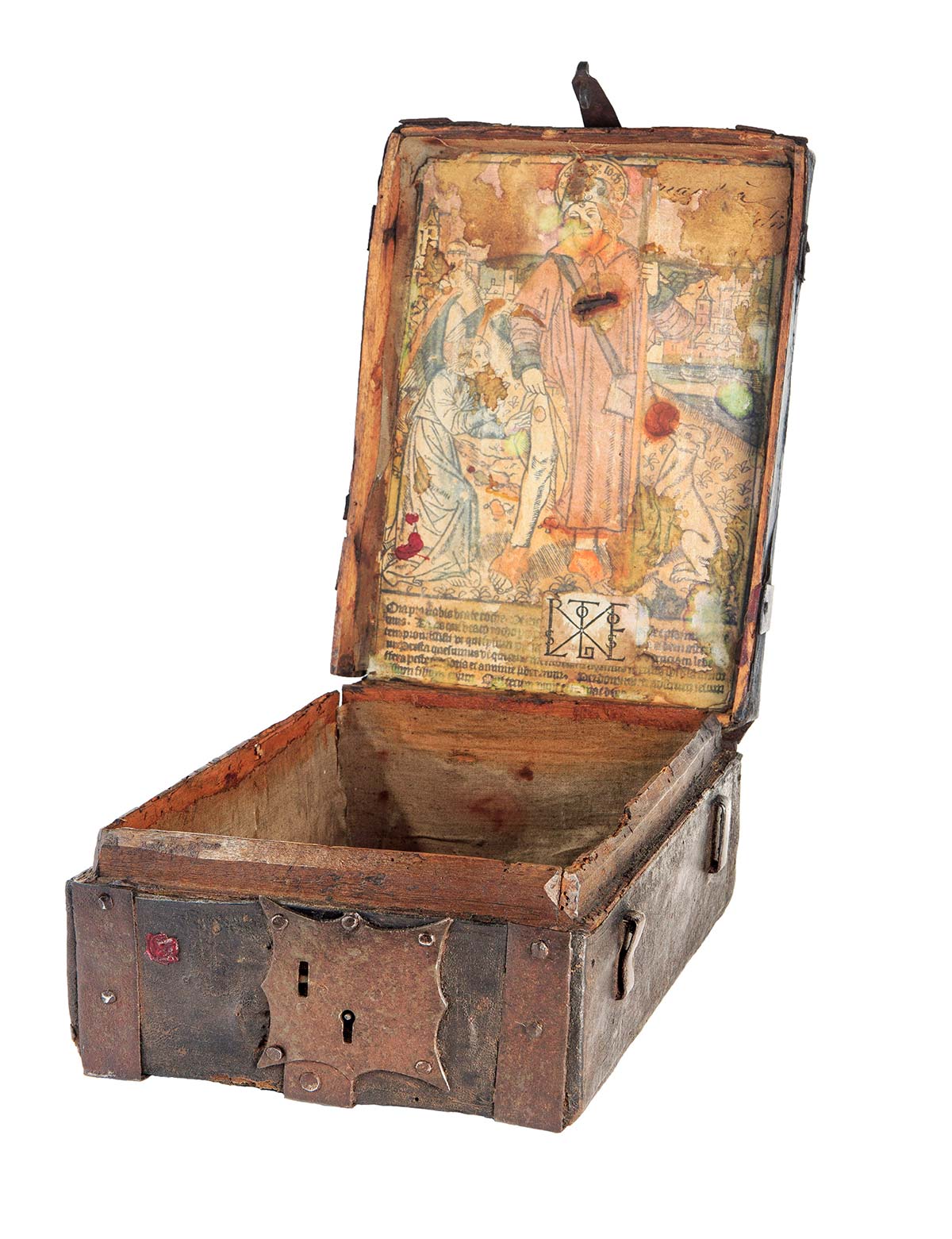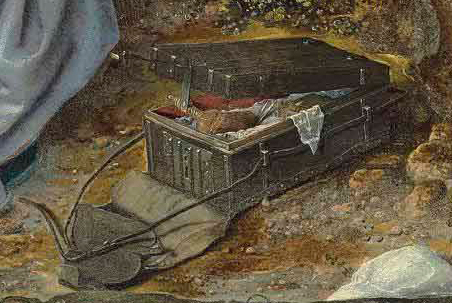At the museum’s first in-person Purchase Party since 2019, the Friends voted to support the acquisition of a rare Gothic coffret dedicated to Saint Roch and adorned with a woodcut print depicting the saint. Coffrets were boxes made to carry personal items—books, relics, and other objects—while traveling. Some were even designed to be worn like a backpack and could also function as small portable altarpieces. Presumably, the owner carried the box on a journey, retrieved a prayer book from inside, and propped it open in order to practice daily prayers.
A Recent Re-Interpretation of Coffrets

This recent interpretation of the function of coffrets stems from the discovery of a Northern Renaissance painting of the Rest on the Flight into Egypt, published by Sandra Hindman in 2015 (“Le Livre, La Photographie, L’Image & La Lettre: Essays in Honor of André Jammes”; Hindman, Sandra, Isabelle Jammes, Bruno James and Hans Kraus, Jr., editors; Published by Aux Éditions des Cendres, Paris, 2015). Painted in Antwerp c. 1530 by an artist working in the tradition of Joachim Patinir, the painting includes a detail of a large, partially opened box. A small leather-bound book with clasps, a rosary composed of precious gems, a brush, scissors, and two finger-rings all nest on a bunch of diaphanous white cloth inside the box. This detail survives as the only known contemporary depiction of these Gothic coffrets. The painting thus encourages us to revisit the question of the purpose of these traveling boxes—symbols of “the house and the garden of the Virgin.” The painting helps clarify the interactive viewing context of Gothic coffrets and confirms the long-held theory of their use as book boxes.
At least half the extant prints are attributed to the Parisian artist Jean d’Ypres (active c. 1490–1508). From a dynasty of painters in northern France, this artist is thought to be identical with the Master of the Très Petites Heures of Anne de Bretagne (variously known also as the Master of the Apocalypse Rose of the Sainte-Chapelle, the Master of the Chasse à la licorne, and the Master of the Life of Saint John the Baptist). This multi-media artist was responsible not only for designs for woodcuts, but for painted altarpieces, stained glass windows, designs for tapestries, and illuminated manuscripts (e.g., his eponymous Book of Hours of Anne de Bretagne). His style, as well as his repertory of models, establishes him as the artistic heir of the Master of Coëtivy, the latter possibly identical with the painter, Colin d’Ypres (active 1450–1485). The documented career of Jean d’Ypres corresponds with that of the Master of the Très Petites Heures of Anne de Bretagne.
Middlebury’s Coffret, with Woodcut of Saint Roch
This particular iteration is an interesting and rare print, one of only four known examples. The print depicts the legend of Saint Roch (1348–1376/79), a pilgrim who was much venerated in France and throughout Europe as a protector against the plague. In the center the saint (identified in part by his name on the halo) points to the wound in his thigh from the plague; on the right appears the dog, who brought him bread for sustenance each day after he retired to the woods, while on the left is the angel who miraculously appeared to cure him. At the end of the fifteenth century, confraternities dedicated to Saint Roch were established in Italy and in France, and when a violent plague struck Paris in the last decade of the century, the Carmelites placed themselves under the saint’s protection.
The xylographic text of a suffrage to Saint Roch appeals to the saint: “Ora pro nobis beate roche. Ut mereamur preservari a peste epidemie Oremus. Deus qui beato Rocho per angelum tuum tabulam eiden afferentem promissisti ut qui ipsum pie invocaverit a nulls pestis cruciate lederetur. Presta quesumus, ut qui eius memoriam agimus meritis ipsius a motifera peste corporis et anime liberemur….” (Pray for us Saint Roch. Let us pray that we may be worthy of being preserved from the plague. God, who through your angel brought the tablet to St. Roch, promised that all those who invoke it piously would never suffer from the plague. We ask that we, for the sake of his memory and through his merits, be saved from the mortal plague of body and soul.).
Source: “Gothic Coffrets.” Online Publication. Text by Sandra Hindman, 2023. Fully illustrated, in English, 35 pages. https://www.lesenluminures.com/gothic-coffrets-the-story-of-an-unusual-art-publication-catalogue/.



